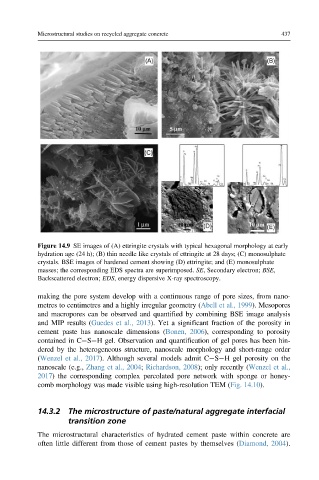Page 487 - New Trends in Eco efficient and Recycled Concrete
P. 487
Microstructural studies on recycled aggregate concrete 437
Figure 14.9 SE images of (A) ettringite crystals with typical hexagonal morphology at early
hydration age (24 h); (B) thin needle like crystals of ettringite at 28 days; (C) monosulphate
crystals. BSE images of hardened cement showing (D) ettringite; and (E) monosulphate
masses; the corresponding EDS spectra are superimposed. SE, Secondary electron; BSE,
Backscattered electron; EDS, energy dispersive X-ray spectroscopy.
making the pore system develop with a continuous range of pore sizes, from nano-
metres to centimetres and a highly irregular geometry (Abell et al., 1999). Mesopores
and macropores can be observed and quantified by combining BSE image analysis
and MIP results (Guedes et al., 2013). Yet a significant fraction of the porosity in
cement paste has nanoscale dimensions (Bonen, 2006), corresponding to porosity
contained in C S H gel. Observation and quantification of gel pores has been hin-
dered by the heterogeneous structure, nanoscale morphology and short-range order
(Wenzel et al., 2017). Although several models admit C S H gel porosity on the
nanoscale (e.g., Zhang et al., 2004; Richardson, 2008); only recently (Wenzel et al.,
2017) the corresponding complex percolated pore network with sponge or honey-
comb morphology was made visible using high-resolution TEM (Fig. 14.10).
14.3.2 The microstructure of paste/natural aggregate interfacial
transition zone
The microstructural characteristics of hydrated cement paste within concrete are
often little different from those of cement pastes by themselves (Diamond, 2004).

